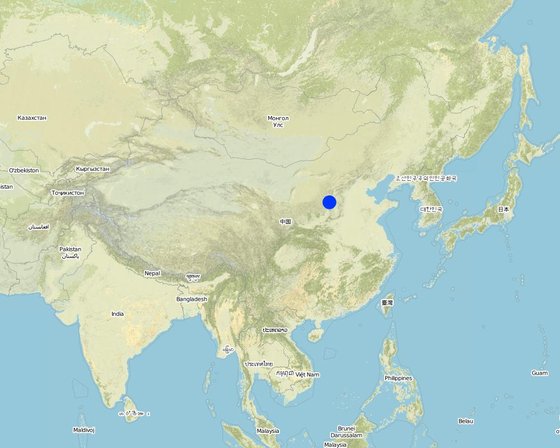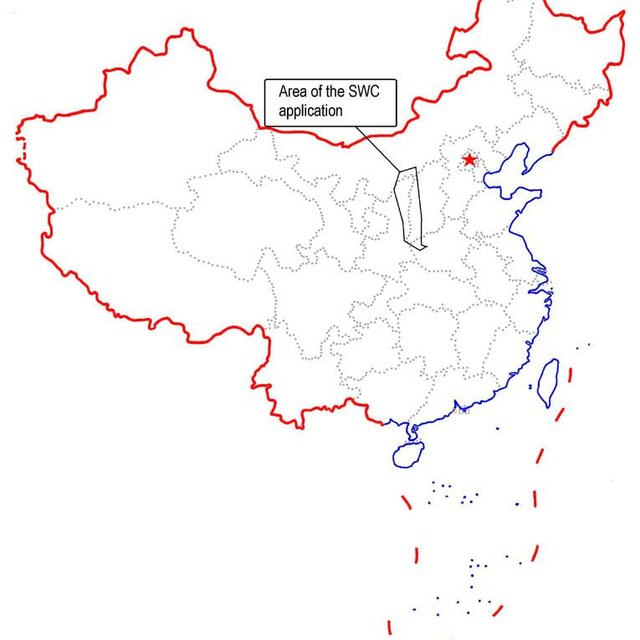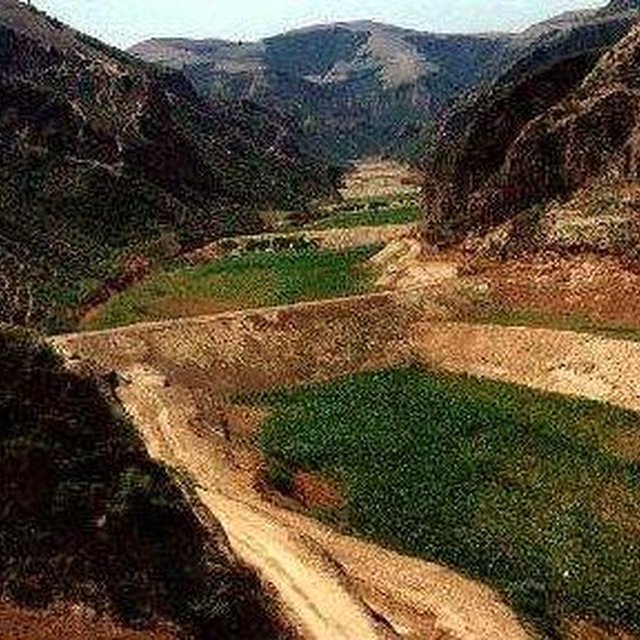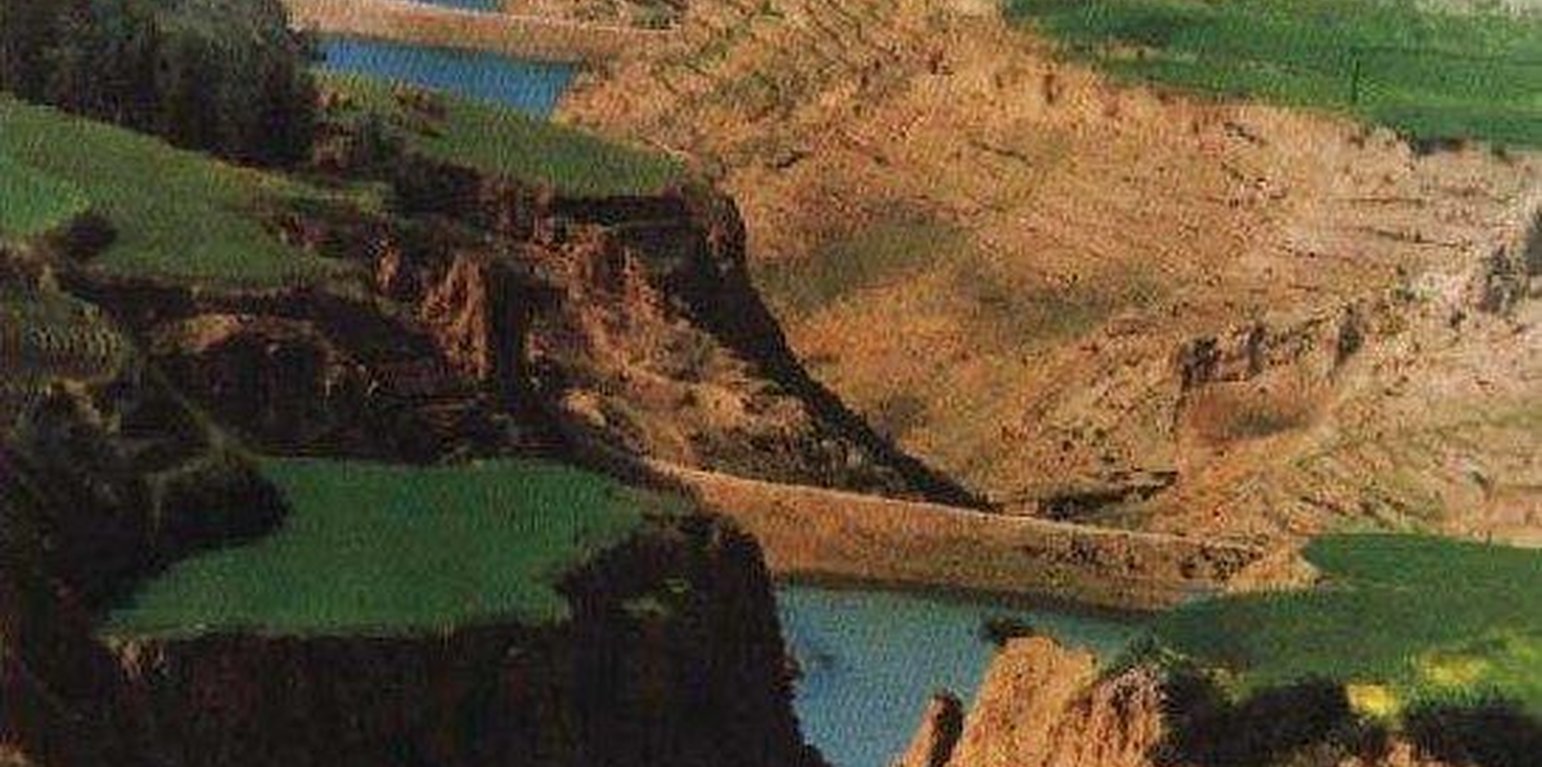Falling Water Dam
(China)
Description
The falling water dams are widely built in the middle reach of the Yellow River, the typical dams are filled with dense slurry by water flow from upland. The approach is implemented mainly by government investment.
Falling water filled dams distribute widely in the middle reaches of the Yellow River. They are used to store water, wrap sediment which results from soil and water loss. On the Loess Plateau, in addition to the conditions of deep gully and steep slope, earth above the top of the dams can be used to build dams. First, soil is loosed with squirt guns, explosion or manually digging. Then, water is pumped up to the loose earth so as to rush the soil down along transporting ditch, turning the soil into dense mud, to dams level surrounded by tamped banks. Under the press of gravity, the mud dehydrates, consolidates and becomes uniformly dense body of the dams. Compared with dams in other areas, the water power filled dams in the Yellow River basin are characterized by much denser mud, uniform particles and body texture, smaller transect of dams body, and wide applicability to soil materials such as sand soil, loess soil and weathering residue. The types of dams have widely applied to build middle and small reservoirs and silt arresters in the middle reaches of the Yellow River, playing an important role in agricultural production and reduction of sediment into the Yellow River.
Location

Location: Shanxi, Shaanxi, etc., China
Geo-reference of selected sites
Initiation date: 1950
Year of termination: 2005
Type of Approach
-
traditional/ indigenous
-
recent local initiative/ innovative
-
project/ programme based

Application area of the Falling Water Dam in the Loess Plateau.

Construction of the falling water dam in the Loess Plateau.
Approach aims and enabling environment
Main aims / objectives of the approach
The objectives of the approach are to control soil & water loss so as to reduce flood; to make more crop land.
The SLM Approach addressed the following problems: The main existing issues are unreasonable land use planning and low use rate; Lower standard of SWC design and poor quality in construction which would lead to flood danger; low administrative level and economic benefits.
Conditions enabling the implementation of the Technology/ ies applied under the Approach
-
Legal framework (land tenure, land and water use rights): The existing land ownership, land use rights / water rights helped a little the approach implementation: Because land resources belongs to state and land user can lease the land.
Conditions hindering the implementation of the Technology/ ies applied under the Approach
-
Availability/ access to financial resources and services: Only when government invests, the technology can be implemented
Treatment through the SLM Approach: investment
Participation and roles of stakeholders involved
Stakeholders involved in the Approach and their roles
| What stakeholders / implementing bodies were involved in the Approach? |
Specify stakeholders |
Describe roles of stakeholders |
| national government (planners, decision-makers) |
|
|
| international organization |
|
|
Involvement of local land users/ local communities in the different phases of the Approach
none
passive
external support
interactive
self-mobilization
initiation/ motivation
rapid/participatory rural appraisal; The approach is a traditional way to harvest water and wrap soils, SWC applied land users easy to understand and accept it if some subsidy being obtained.
planning
workshops/seminars; After a program granted, implementing agency and local communities working together.
implementation
responsibility for major steps; In practice, local communities are the major part to manager and carry out.
monitoring/ evaluation
interviews/questionnaires; When monitoring procedures are clear, the local communities could do this and evaluate.
Research
Only can give some suggestions or questionnaire.
Decision-making on the selection of SLM Technology
Decisions were taken by
-
land users alone (self-initiative)
-
mainly land users, supported by SLM specialists
-
all relevant actors, as part of a participatory approach
-
mainly SLM specialists, following consultation with land users
-
SLM specialists alone
-
politicians/ leaders
Decisions were made based on
-
evaluation of well-documented SLM knowledge (evidence-based decision-making)
-
research findings
-
personal experience and opinions (undocumented)
Technical support, capacity building, and knowledge management
The following activities or services have been part of the approach
-
Capacity building/ training
-
Advisory service
-
Institution strengthening (organizational development)
-
Monitoring and evaluation
-
Research
Capacity building/ training
Training was provided to the following stakeholders
-
land users
-
field staff/ advisers
Form of training
-
on-the-job
-
farmer-to-farmer
-
demonstration areas
-
public meetings
-
courses
Subjects covered
How to maintain and reinforce the dams
Advisory service
Advisory service was provided
-
on land users' fields
-
at permanent centres
Name of method used for advisory service: Falling water dam show; Key elements: Selection of site for dam building, size of dam, materials and methods; 1) Mainly: projects own extension structure and agents, Partly: government's existing extension system 2) Mainly: projects own extension structure and agents, Partly: government's existing extension system; Extension staff: mainly government employees 3) Target groups for extension: land users; Activities: demonstration
Advisory service is quite adequate to ensure the continuation of land conservation activities; At each government level, there is a SWC office which is in charge of SWC activities including extension.
Institution strengthening
Institutions have been strengthened / established
-
no
-
yes, a little
-
yes, moderately
-
yes, greatly
Describe institution, roles and responsibilities, members, etc.
Type of support
-
financial
-
capacity building/ training
-
equipment
Further details
Monitoring and evaluation
area treated aspects were ad hoc monitored through measurements
land users involved aspects were ad hoc monitored through measurements
There were few changes in the Approach as a result of monitoring and evaluation
Research
Research treated the following topics
-
sociology
-
economics / marketing
-
ecology
-
technology
Pattern and standards for the dam design.
Research was carried out both on station and on-farm
Financing and external material support
Annual budget in USD for the SLM component
-
< 2,000
-
2,000-10,000
-
10,000-100,000
-
100,000-1,000,000
-
> 1,000,000
Precise annual budget: n.a.
Approach costs were met by the following donors: government (national - The central government): 85.0%; local community / land user(s) (Village committee): 5.0%; other (World Bank): 10.0%
The following services or incentives have been provided to land users
-
Financial/ material support provided to land users
-
Subsidies for specific inputs
-
Credit
-
Other incentives or instruments
partly financed
fully financed
equipment: machinery
subsidy
community infrastructure
financed by government
Labour by land users was
-
voluntary
-
food-for-work
-
paid in cash
-
rewarded with other material support
Credit
-
Conditions: Interest rate charged: 4.0%; repayment conditions: After 4 or 5 years when SWC produces benefits, loaner should return.
Interest was lower than market rate.
-
Credit providers: n.a.
-
Credit receivers: n.a.
Impact analysis and concluding statements
Impacts of the Approach
No
Yes, little
Yes, moderately
Yes, greatly
Did the Approach help land users to implement and maintain SLM Technologies?
They can harvest water and irrigate crops in dry seasons. Meanwhile, more crop land area is made.
Did the Approach improve issues of land tenure/ user rights that hindered implementation of SLM Technologies?
The policies of land contract distribute land to individuals so that land users who involved in SWC activities need to be organized together for implementation of the SWC. The organization need much time and hard work.
The problem is likely to be overcome in the near future. Administrative management can adjust and assort with this issue.
Did other land users / projects adopt the Approach?
Main motivation of land users to implement SLM
Sustainability of Approach activities
Can the land users sustain what hat been implemented through the Approach (without external support)?
Conclusions and lessons learnt
Strengths: land user's view
-
Raising crop production and return (How to sustain/ enhance this strength: applying fertilizers as possible as can)
-
water can be irrigated in dry seasons and drinks both for cattle and man (How to sustain/ enhance this strength: maintaining and repairing if needed.)
Strengths: compiler’s or other key resource person’s view
-
Storing water (How to sustain/ enhance this strength: reducing vapour and leak as possible as can)
-
Enlarge cropland and raising yield (How to sustain/ enhance this strength: shifting food crops to cash crops)
-
reducing flooding (How to sustain/ enhance this strength: reinforce the dams timely)
Weaknesses/ disadvantages/ risks: land user's viewhow to overcome
-
Costly and frenquently reinforce
Weaknesses/ disadvantages/ risks: compiler’s or other key resource person’s viewhow to overcome
-
The dams' quality are not high
standardization for design and construction
References
Date of documentation: Jan. 28, 2009
Last update: July 19, 2017
Resource persons
-
Yan ZHANG (baoyuan+changeme4@bnu.edu.cn) - SLM specialist
-
Baoyuan Liu (baoyuan@bnu.edu.cn0) - SLM specialist
Full description in the WOCAT database
Documentation was faciliated by
Institution
- Department of Resources and Environmental Science, Beijing Normal University (Department of Resources and Environmental Science, Beijing Normal University) - China
Project
Key references
-
Special Planning Of Soil And Water Conservation in Xinzhou Region , Shanxi Province, 1986-1990: Library of the Resource and Environmental Department, Beijing Normal University.
-
How to design the dry masonry dam in the Hanjiachuan watershed. Tianyuzhu, Wangzuliang. Beijing. Water conservation in Beijing, 2000: Library of the Resource and Environmental Department, Beijing Normal University.






